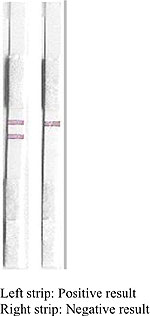
Abstract:
A Greek company has developed a test procedure, whereby amplified DNA is detected by the use of a dry reagent strip, based on oligonucleotide-coupled gold nanoparticles and nucleotide bonds. This can be used as a stand-alone DNA detection device, or be part of a complete kit for molecular detection of
microorganisms, genetic material, genetically engineered food and crops. The procedure is fast, simple and safe. The company seeks marketing and commercial partners.
Description:
The device developed by a Greek company comprises of a dry reagent lateral flow strip and two reagents: 1) a probe, a complimentary sequence to the ssDNA (single-stranded deoxyribonucleic acid) target that bears a poly-adenine tail and 2) a running buffer.
Biotinylated PCR (polymerase chain reaction) product, in the presence of the probe, is heated at 95ΊC for 2 min (denaturation) and then cooled at 37ΊC for 5 min (hybridisation of target DNA probe). The mixture is then added to the strip, where colloidal gold spheres with chemically bonded poly-thymine
tails are nested, so A-T (Adenine-Thymine) bonds are formed, linking the target DNA probe complex to gold particles.
Following a chromatographic lateral flow the gold-target DNA probe complexes are transferred across the strip, to the test zone, where streptavidin is anchored. The complexes are bound on the test zone by biotin-streptavidin bonds, forming a red Test Line.
The mixture subsequently reaches the control line, where adenine is bound to the membrane. The excess gold particles are then bound on this line, by A-T bonds, forming a Control Line.
The formation of two red lines, no matter how faint the test line is, signifies that biotinylated PCR product was present, thus a positive result. If only the control line is visible, the test is negative.
The test must be repeated if only the test line is visible.
Sensitivity is much higher than DNA electrophoresis and specificity is ensured by the initial hybridisation step of the probe to the target DNA. The test is able to identify DNA sequences 40-500 bp long, fast, completed in 20 minutes after PCR, it does not require special equipment and results are evaluated
visually. Sensitivity is much better versus DNA electrophoresis, as a visually positive result is reported with as little as 1.9 fmol DNA.
Innovative Aspects:
The strip is based on oligonucleotide-bound gold particles and does not use immunological reactions for binding.
- Oligonucleotide-bound gold particles are bound and stabilised on a membrane in dry reagent form.
- Oligonucleotide-bound gold particles are spontaneously reconstituted upon contact to the development buffer.
- In-flow Adenine-Thymine hybridisation is used for binding.
Main Advantages:
- This procedure is fast, allowing detection of amplified DNA sequences in a few (10-20?) minutes.
- It does not use special equipment and dangerous materials.
- Minimally trained users can read and validate results.
- Sensitivity is much higher than DNA electrophoresis.
- Used strips are non-polluting.
- Used strips can be kept developed for years.
Technology Keywords:
- Cytology, Cancerology, Oncology
- Diagnostics, Diagnosis
- Cellular and Molecular Biology
- Genetic Engineering
- In vitro Testing, Trials
- Microbiology
- Food Microbiology / Toxicology / Quality Control
| Technology Keywords: |
Cytology, Cancerology, Oncology
Diagnostics, Diagnosis
Cellular and Molecular Biology
Genetic Engineering
In vitro Testing, Trials
Microbiology
Food Microbiology / Toxicology / Quality Control
|
| Current Stage of Development: |
Available for demonstration |
| Exploitation of RTD Results: |
PRIVATE RESEARCH |
| Intellectual Property Rights: |
Patent(s) applied for but not yet granted |
| |
Comments
The company has applied for a patent to the Hellenic Organisation of Industrial Property (OBI). Application number: 20020100485/07.11.2002
|
| Organisation/Company Type: |
Industry |
| Organisation/Company Size: |
50-249 |
| Brief Market Application Codes: |
Biotechnology
Food - Agro Industry
Medicine, health
|
| Detailed Market Application Codes (VEIC): |
Keywords
Diagnostic
Diagnostic test products and equipment
Highlights
This device can be used as a component in molecular-biology-based diagnostic kits. Their first kit allows the detection of Ep-CAM (Epithelial Cell Adhesion Molecule) mRNA, means for the detection of cancer cells in circulating blood (metastasis).
|
| Collaboration Type: |
Technical Co-operation
License agreement
Commercial Agreement with Technical Assistance
|
| |
Comments
Partner sought expertised in development and/or marketing of molecular diagnostic products, with global reach.
|
Additional Information:
National Documentation Centre
Mr George Apostolopoulos
+30 10 7273920
+30 10 7246824
E-mail: [email protected]

 Έρευνα στην Ελλάδα
Έρευνα στην Ελλάδα
 Προγράμματα
Προγράμματα
 Αξιοποιήσιμα Αποτελέσματα
Αξιοποιήσιμα Αποτελέσματα

